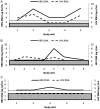Patterns and causes of suboptimal response to tenofovir-based therapy in individuals coinfected with HIV and hepatitis B virus
- PMID: 23315316
- PMCID: PMC3693490
- DOI: 10.1093/cid/cit002
Patterns and causes of suboptimal response to tenofovir-based therapy in individuals coinfected with HIV and hepatitis B virus
Abstract
Background: Tenofovir (TDF) is effective for treatment of hepatitis B virus (HBV) in human immunodeficiency virus (HIV) infection; however, some individuals have ongoing HBV viremia, the reasons for which are unclear. We determined the patterns and factors associated with detectable HBV DNA in HIV-HBV-coinfected subjects on highly active antiretroviral therapy (HAART).
Methods: One hundred sixty-five HIV-HBV-coinfected individuals from the United States, Australia, and Thailand, the majority of whom were on HAART at study entry, were prospectively followed semiannually for a median of 2.8 years. Logistic regression was used to determine factors associated with detectable HBV DNA.
Results: Anti-HBV regimens were TDF/emtricitabine (57%), lamivudine or emtricitabine (19%), or TDF monotherapy (13%). During follow-up, HBV DNA was detected at 21% of study visits and was independently associated with hepatitis B e antigen (HBeAg), HAART <2 years, CD4 <200 cells/mm(3), detectable HIV RNA, reporting <95% adherence, and anti-HBV regimen. TDF/emtricitabine was less likely to be associated with detectable HBV than other regimens, including TDF monotherapy (odds ratio, 2.79; P = .02). In subjects on optimal anti-HBV therapy (TDF/emtricitabine) and with undetectable HIV RNA, HBeAg, CD4 <200 mm(3), and reporting <95% adherence remained associated with detectable HBV DNA. Three main patterns of HBV viremia were observed: persistent HBV viremia, viral rebound (>1 log from nadir), and viral blips. No TDF resistance was identified.
Conclusions: Tenofovir/emtricitabine was superior to other anti-HBV regimens in long-term HBV suppression. HBV viremia on therapy was identified in 1 of 3 main patterns. Suboptimal adherence was associated with detectable HBV DNA during therapy, even when HIV was undetectable.
Figures


Similar articles
-
Persistent viremia in human immunodeficiency virus/hepatitis B coinfected patients undergoing long-term tenofovir: virological and clinical implications.Hepatology. 2014 Aug;60(2):497-507. doi: 10.1002/hep.27182. Epub 2014 Jun 20. Hepatology. 2014. PMID: 24752996 Clinical Trial.
-
Role of a 48-week pegylated interferon therapy in hepatitis B e antigen positive HIV-co-infected patients on cART including tenofovir: EMVIPEG study.J Hepatol. 2014 Oct;61(4):761-9. doi: 10.1016/j.jhep.2014.05.030. Epub 2014 Jun 2. J Hepatol. 2014. PMID: 24882048 Clinical Trial.
-
Effects of long-term tenofovir-based combination antiretroviral therapy in HIV-hepatitis B virus coinfection on persistent hepatitis B virus viremia and the role of hepatitis B virus quasispecies diversity.AIDS. 2016 Jun 19;30(10):1597-606. doi: 10.1097/QAD.0000000000001080. AIDS. 2016. PMID: 26950313
-
Suppression of HBV by tenofovir in HBV/HIV coinfected patients: a systematic review and meta-analysis.PLoS One. 2013 Jul 10;8(7):e68152. doi: 10.1371/journal.pone.0068152. Print 2013. PLoS One. 2013. PMID: 23874527 Free PMC article.
-
[Hepatitis B in patients with HIV infection].Enferm Infecc Microbiol Clin. 2008 May;26 Suppl 7:71-9. doi: 10.1016/s0213-005x(08)76522-4. Enferm Infecc Microbiol Clin. 2008. PMID: 19100234 Review. Spanish.
Cited by
-
Spectrum of Liver Disease in Hepatitis B Virus (HBV) Patients Co-infected with Human Immunodeficiency Virus (HIV): Results of the HBV-HIV Cohort Study.Am J Gastroenterol. 2019 May;114(5):746-757. doi: 10.1038/s41395-018-0409-9. Am J Gastroenterol. 2019. PMID: 30410040 Free PMC article.
-
HIV-hepatitis B virus coinfection: epidemiology, pathogenesis, and treatment.AIDS. 2017 Sep 24;31(15):2035-2052. doi: 10.1097/QAD.0000000000001574. AIDS. 2017. PMID: 28692539 Free PMC article. Review.
-
Hepatitis B virus coinfection in human immunodeficiency virus-infected patients: a review.World J Gastroenterol. 2014 Oct 28;20(40):14598-614. doi: 10.3748/wjg.v20.i40.14598. World J Gastroenterol. 2014. PMID: 25356024 Free PMC article. Review.
-
HBV genotypes and response to tenofovir disoproxil fumarate in HIV/HBV-coinfected persons.BMC Gastroenterol. 2015 Jul 8;15:79. doi: 10.1186/s12876-015-0308-0. BMC Gastroenterol. 2015. PMID: 26152237 Free PMC article.
-
Treatment advantage in HBV/HIV coinfection compared to HBV monoinfection in a South African cohort.J Infect. 2020 Jul;81(1):121-130. doi: 10.1016/j.jinf.2020.04.037. Epub 2020 May 1. J Infect. 2020. PMID: 32360882 Free PMC article.
References
-
- Hoffmann CJ, Thio CL. Clinical implications of HIV and hepatitis B co-infection in Asia and Africa. Lancet Infect Dis. 2007;7:402–9. - PubMed
-
- Matthews G, Cooper DA, Dore G. Improvements in parameters of end stage liver disease in patients with HIV/HBV-related cirrhosis treated with tenofovir. Antiviral Therapy. 2007;12:119–22. - PubMed
-
- Benhamou Y, Fleury H, Trimoulet P, et al. Anti-hepatitis B virus efficacy of tenofovir disoproxil fumarate in HIV-infected patients. Hepatology. 2006;43:548–55. - PubMed
-
- Nelson M, Portsmouth S, Stebbing J, et al. An open-label study of tenofovir in HIV-1 and hepatitis B virus coinfected individuals. AIDS. 2003;17:F7–10. - PubMed
-
- Martin-Carbonero L, Teixeira T, Poveda E, et al. Clinical and virological outcomes in HIV-infected patients with chronic hepatitis B on long-term nucleos(t)ide analogues. AIDS. 2011;25:73–9. - PubMed
Publication types
MeSH terms
Substances
Grants and funding
- U01 AI035042/AI/NIAID NIH HHS/United States
- UL1 RR025005/RR/NCRR NIH HHS/United States
- R56 AI060449/AI/NIAID NIH HHS/United States
- UO1-AI-35041/AI/NIAID NIH HHS/United States
- U01 AI035041/AI/NIAID NIH HHS/United States
- UL1-RR025005/RR/NCRR NIH HHS/United States
- U01 AI035043/AI/NIAID NIH HHS/United States
- UO1-AI-35039/AI/NIAID NIH HHS/United States
- U01 AI035040/AI/NIAID NIH HHS/United States
- U01 AI035039/AI/NIAID NIH HHS/United States
- UO1-AI-35043/AI/NIAID NIH HHS/United States
- UO1-AI-35040/AI/NIAID NIH HHS/United States
- R56AI60449/AI/NIAID NIH HHS/United States
LinkOut - more resources
Full Text Sources
Other Literature Sources
Medical
Research Materials

